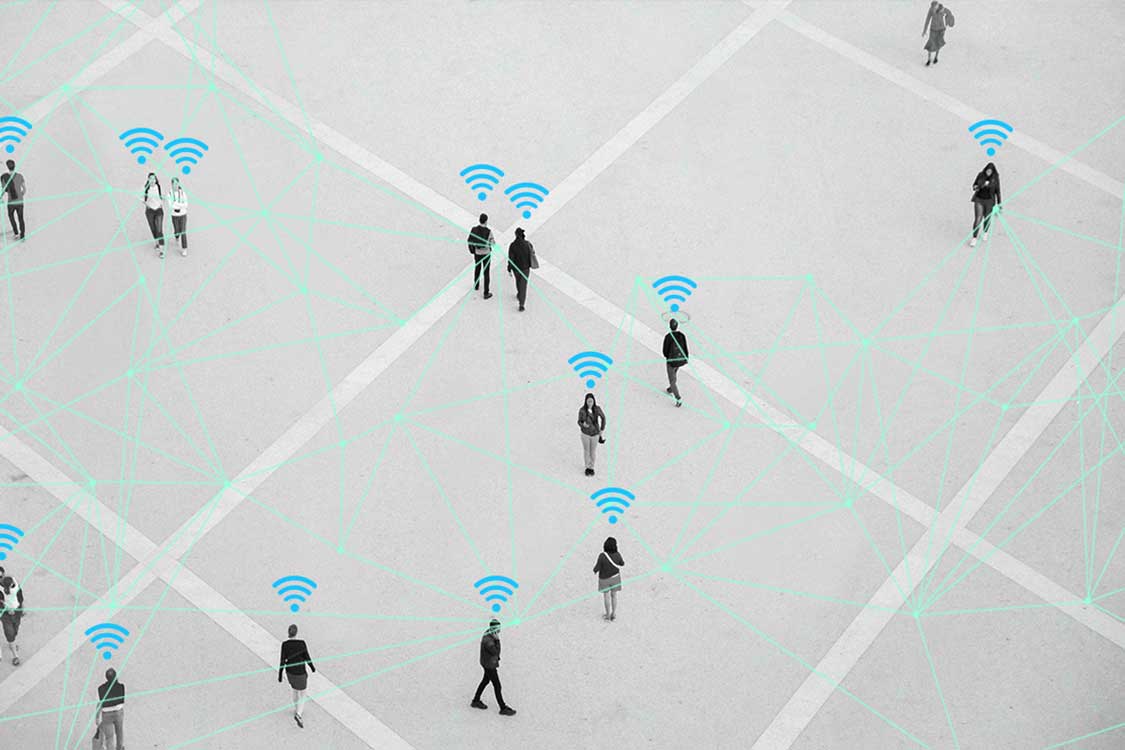Technology Trends

Location Fingerprinting – Pros, Cons and Alternatives
What factors would you consider when choosing an indoor fingerprinting positioning system provider? If you want to integrate a dynamic floor plan with a blue dot navigation provider, you need to ensure accuracy, scalability and flexibility. Technology has evolved over the years and some have proven to be more reliable than others.
Even though wireless fidelity has remained a top choice for years, it requires routine maintenance, putting a strain on organizations looking for affordable alternatives. To understand the best indoor positioning method, we need to understand what location fingerprinting is and why it is important.
What is Location Fingerprinting?
In an indoor positioning system, location fingerprinting is one of several top positioning techniques used. In real-time, receiver antennas measure signal strength to determine a mobile target’s location. Signal data is inferred as Received Signal Strength (RSS) or the distance between the mobile target and transmitting beacons.


How Does Location Fingerprinting Work?
It is possible to create a fingerprinting map that shows live signal strengths by creating a database of signal hotspots within a large setting. To record the RSSI of every cell within a grid, a virtual grid is drawn inside a space, covering all tractable areas.
The fingerprinting method uses RSS to estimate the mobile device’s real-time location by comparing it with known signal data. With a fair degree of accuracy, it can measure the distance between the broadcasting sensor and the mobile device.
When you are undecided on indoor positioning criteria, here are a few pointers to keep in mind.
- Accuracy –
- Scalability –
- Flexibility – to track real-time changes to the environment.
The fingerprinting method has been claimed to offer the best accuracy, scalability and adaptability over the years, but do these claims hold? We’ll find out.
Fingerprinting indoor positioning is a localization technique with two phases – online testing and offline training.
We’ll start with offline training. The fingerprinting algorithm is trained at this stage using Received Signal Strength Indicator (RSSI) data collected from various points across the floor grid. Access Points, User Devices and Reference Points are all part of it. Each of these grid points acts as a digital landmark for the algorithm to understand the surroundings. In algorithmic learning, sensor-equipped devices must be physically carried to all grid points within the venue, which includes walking every inch of the floor to record signal strength data. This information, along with the location coordinates, is stored in a database. They form the Reference Point for the fingerprinting algorithm.
The online testing phase entails matching the RSSI readings from the beacon with database values to estimate the location of the mobile target. The RSS value sourced at random from the floor grid serves as the location fingerprint in this case.
Here’s what happens when you navigate the floor for algorithmic calibration:
- The beacon communicates with Access Points.
- The inbound signals are read by the mobile device.
- The device’s signal strength is measured and the Reference Point data is sent back to the fingerprint database on a server.
- The signal data is matched with the stored values in the database for real-time device localization.
The Pros and Cons of Location Fingerprinting
Fingerprint Positioning Advantages
In Wi-Fi-based methods, fingerprinting is a popular localization technique. Apple and Google wearables use Wi-Fi Fingerprinting to locate wearers within a contained environment with an accuracy of up to 15 meters.
Fingerprinting is a popular choice due to the ease with which signal strength can be measured. With a large number of beacons deployed, accuracy can be improved because the algorithm only needs to match the fingerprinting database to triangulate mobile targets.
Fingerprint Positioning Disadvantages
However, fingerprinting is not without its flaws. Because of the simpler algorithms, the system is unsuitable for complex localizations, especially in difficult environments with many dead zones.
Here are some of the reasons why fingerprinting may not be the holy grail of indoor localization techniques –
- If the indoor environment is constantly changing, fingerprinting may not produce consistent readings. It necessitates frequent calibration of reference points. This time-consuming process usually requires hours spent cataloging changes to the physical environment. Fingerprinting becomes uneconomical and time-consuming in hybrid workspaces, airports and other environments where change is constant.
- Because the signal data is always stored on a server, fingerprinting is ineffective offline. This causes localization apps to perform less optimally and on demand when the server is unavailable or the location data is obsolete. The delay in retrieving live location data is a barrier to accurate real-time fingerprint positioning. Users are greatly inconvenienced in signal dead zones and areas without internet access.
- Without due diligence, the fingerprinting method is prone to calibration errors. To avoid Reference Point errors, the calibrator must map the entire premises step by step. Calibration may have to be repeated if captured data is inconsistent. Recalibration may also be required following minor changes to the environment, such as moving furniture or office cabinets from their previous location.
- The fingerprinting method’s performance is linked to the number of sensors installed in the calibration area. Only by deploying more sensors can more accurate RSSI be captured. Because the system is so reliant on sensors, it is vulnerable to interference from physical obstacles, foot traffic, routers, Bluetooth devices and other access points.
- More Access Points improve stability and accuracy, but deploying AP in large numbers is expensive and each time the environment changes, the algorithm must be retrained, adding to the cost of manpower.
- Fingerprinting techniques are not scalable. The tediousness of covering large areas adds to the overall complexity of collecting fingerprinting data as the facility size grows. Fingerprinting has historically failed to scale efficiently, making it unsuitable for mapping large venues.
Airport Wayfinding with Fingerprinting Positioning
Fingerprinting positioning is an essential component of airport wayfinding systems, enabling seamless navigation for travelers. By utilizing indoor localization techniques, fingerprinting mapping creates a real-time digital representation of the airport, guiding passengers to gates, baggage claims, lounges and security checkpoints.
One of the key advantages of using fingerprinting positioning in airports is its ability to function accurately in GPS-restricted environments. Traditional airport wayfinding solutions rely on fixed signage, which can be confusing in large and busy terminals. However, fingerprinting technology enables a blue dot navigation system that updates in real-time based on Received Signal Strength Indicator (RSSI) data, ensuring travelers always have accurate location information at their fingertips.
Despite its advantages, fingerprinting positioning in airport wayfinding has challenges. Environmental changes such as moving crowds, furniture adjustments or new installations may require recalibration, making maintenance-intensive solutions less viable for dynamic environments. Alternatives like sensor-free AI-based wayfinding provide better scalability while maintaining high accuracy in large transportation hubs.
A Better Alternative to Fingerprinting
Mapsted has built a system that is hardware-free and does not use traditional fingerprint indoor localization techniques. Mapsted uses machine learning for blue-dot navigation, eliminating the complexity of configuring, running and scaling fingerprinting operations. In most indoor conditions, Mapsted’s method of calibration reduces positioning errors and improves wayfinding precision by up to one meter.
Conclusion
Because real-time indoor localization techniques are set up at the device end rather than relying on GPS, the Internet or other signal sources, Mapsted’s location estimation excludes the need for fingerprinting. This makes the system not only accurate but also reliable in signal dead zones such as basements, parking lots and building transition points. Mapsted’s solution is more agile and simple to use than most traditional options because no hardware is required across the floor.
Frequently Asked Questions
Q1. What is fingerprinting in indoor positioning?
Ans. Location Fingerprinting is a positioning technique that uses Received Signal Strength to locate indoor targets (RSS). The distance between the mobile device and the nearest beacons aids in determining the real-time position.
Q2. How accurate is indoor positioning system Using fingerprinting localization?
Ans. Given that the area is extensively covered by beacons or sensors, fingerprint localization is accurate up to 15 metres. The greater the number of beacons, the greater the real-time accuracy.
Q3. What is RSS fingerprint?
Ans. It is the unit responsible for creating radio maps of the venue using fingerprinting techniques. The fingerprinting algorithm compares online and offline fingerprint data to estimate location.
Q4. What is Wi-Fi fingerprinting?
Ans. The mobile asset is assigned a tag that reads the base station ID of all Access Points in the environment and reports the signal strength mapped to each AP in Wi-Fi fingerprinting. This allows the indoor positioning system to locate the asset in real time.
Q5. Why is fingerprint-based indoor localization still so hard?
Q6: How does fingerprinting positioning improve airport wayfinding?
A: Fingerprinting positioning enables precise indoor navigation in airports by utilizing Wi-Fi, Bluetooth or sensor signals to create a digital map of the terminal. Passengers can access real-time location updates through an app, allowing them to find check-in counters, security gates and baggage claim areas with ease.
Q7: What are the limitations of fingerprinting-based airport wayfinding?
A: While fingerprinting offers accurate indoor positioning, it requires frequent recalibration due to environmental changes. High foot traffic, structural adjustments and new obstacles may affect accuracy, making hardware-free machine learning-based solutions a better alternative in fast-changing environments like airports.
Q8: Why is fingerprinting positioning preferred for indoor navigation in airports?
A: Fingerprinting positioning is commonly used in airport wayfinding because it works in GPS-restricted environments, such as large terminals, underground walkways and multi-level airport structures. It provides real-time indoor localization by mapping signal strengths from Wi-Fi, Bluetooth or sensor beacons, helping passengers navigate efficiently.
Q9: Can fingerprinting positioning work without Wi-Fi or Bluetooth in airports?
A: Traditional fingerprinting positioning relies on Wi-Fi, Bluetooth or RFID beacons for signal mapping. However, hardware-free AI-based alternatives, like those developed by Mapsted, eliminate the need for external hardware while improving location accuracy in airports and large venues.
Q10: How does fingerprinting compare to beacon-based airport wayfinding?
A: Fingerprinting relies on existing wireless signals, while beacon-based wayfinding requires deploying additional Bluetooth Low Energy (BLE) beacons. Beacons offer better accuracy in some cases but require frequent maintenance and higher costs due to battery replacements and calibration efforts.
Q11: What is fingerprint protection in geolocation?
A: Fingerprint protection in geolocation refers to privacy and security measures that prevent unauthorized access to location-based data collected through fingerprinting positioning. It ensures personal location data remains secure, preventing tracking or misuse without user consent.
